一、File类的使用
File类的使用
java.io.File类: 文件和文件目录路径的抽象表示形式,与平台无关
File能新建、删除、重命名文件和目录,但File不能访问文件内容本身。如果需要访问文件内容本身,则需要使用输入/输出流
想要在Java程序中表示一个真实存在的文件或目录,那么必须有一个File对象,但是Java程序中的一个File对象, 可能没有一个真实存在的文件或目录
File对象可以作为参数传递给流的构造器
路径分隔符
? windows:\
? unix:/
常用方法
package com.caq.java;
import org.junit.Test;
import java.io.File;
/**
* File类的使用
*
* 1.File类的一个对象,代表一个文件或一个文件目录
* 2.File类声明在java.io包下
*
*
*
*
*/
public class FileDemo01 {
/**
1.如何创建File类的实例
File(String pathname)
File(String parent,String child)
2.相当路径:相较于某个路径下,指明的路径
绝对路径:包含盘符在内的文件或者文件夹的路径
3.路径分隔符
windows:\\
unix:/
*/
@Test
public void test1(){
/**
public File(String pathname)
以pathname为路径创建File对象,可以是绝对路径或者相对路径,如果
pathname是相对路径,则默认的当前路径在系统属性user.dir中存储。
绝对路径:是一个固定的路径,从盘符开始
相对路径:是相对于某个位置开始
public File(String parent,String child)
以parent为父路径,child为 子路径创建File对象。
public File(File parent,String child)
根据一个父File对象和子文件路径创建File对象
*/
//构造器一
File f1 = new File("hello.txt");//相对于当前moudle
File f2 = new File("D:\\Code\\he.txt");//加两个杠是因为不想让它进行转义
System.out.println(f1);
System.out.println(f2);
//构造器二
File f3 = new File("\\Code", "test");
System.out.println(f3);
//构造器三
File f4 = new File(f3,"hello.txt");
System.out.println(f4);
}
}
二、IO流原理及流的分类
JavaIO原理
I/O是Input/Output的缩写,I/O技 术是非常实用的技术,用于处理设备之间的数据传输。如读/写文件,网络通讯等
Java程序中,对于数据的输入/输出操作以==“流(stream“==的方式进行
java.io包下提供了各种“流”类和接口,用以获取不同种类的数据,并通过标准的方法输入或输出数据。
-
输入input:读取外部数据(磁盘、光盘等存储设备的数据)到程序(内存)中
-
输出output:将程序(内存) 数据输出到磁盘、光盘等存储设备中
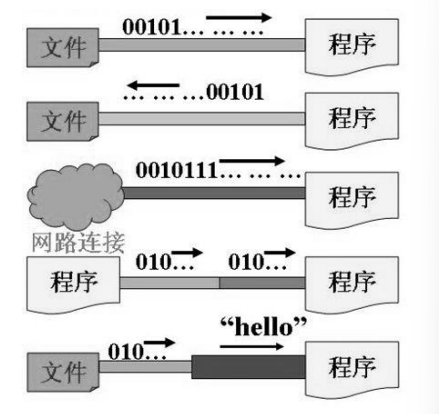
流的分类
按操作数据单位不同分为:字节流(8bit),字符流(16bit)
字节就是一个byte(010101),常用来处理图片啊,视频啊之类的
一个一个的char(2个字节),常用来处理字符,比如文本之类的
按数据流的流向不同分为:输入流,输出流
输入:读取外部数据到内存中
输出:将内存中数据输出到磁盘,光盘等位置
按流的角色的不同分为:节点流,处理流
节点流:流直接作用在节点上
处理流:流作用在已有的流上的
流的分类
| 抽象基类 | 字节流 | 字符流 |
|---|---|---|
| 输入流 | InputStream | Reader |
| 输出流 | OutputStream | Writer |
- Java的IO流共涉及40多个类,实际上非常规则,都是从如下4个 抽象基类派生的。
- 由这四个类派生出来的子类名称都是以其父类名作为子类名后缀。
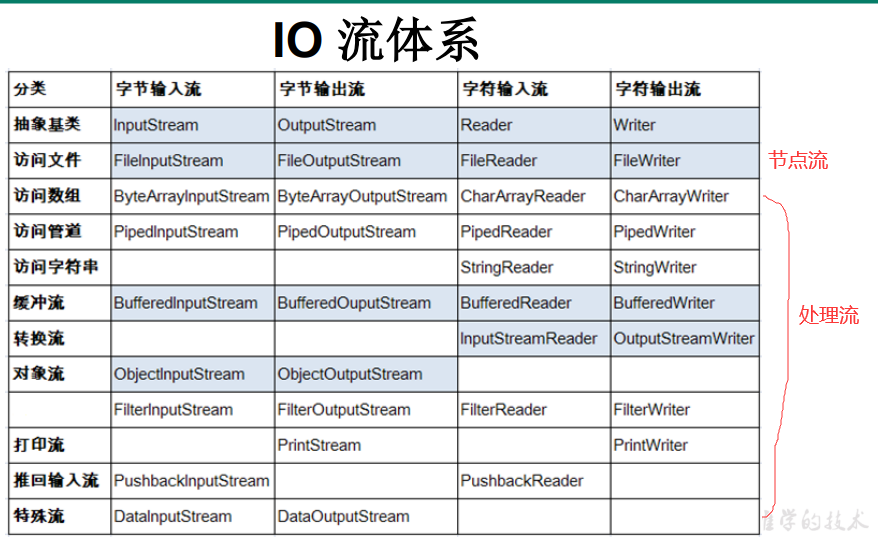
节点流和处理流
节点流 :直接从数据源或目的地读写数据

处理流:不直接连接到数据源或目的地,而是“连接”在已存在的流(节点流或处理流)之上,通过对数据的处理为程序提供更为强大的读写功能。

InputStream & Reader
InputStream和Reader是所有输入流的基类
InputStream (典型实现: FileInputStream)
? int read()
? int read(byte[] b)
? int read(byte[] b, int off, int len)
Reader (典型实现: FileReader )
? int read()
? int read(char [] c)
? int read(char 0 C, int off, int len)
?
程序中打开的文件IO资源不属于内存里的资源,垃圾回收机制无法回收该资源,所以应该显式关闭文件IO资源
FileInputStream从文件系统中的某个文件中获得输入字节FileInputStream用于读取非文本数据之类的原始字节流。要读取字符流,需要使用FileReader
InputStream
-
int read()
从输入流中读取数据的下一个字节。返回0到255范围内的int字节值。如果因为己经到达流末尾而没有可用的字节,则返回值-1 -
int read(byte[] b)
从此输入流中将最多b.length 个字节的数据读入一个byte数组中。如果因为已经到达流末尾而没有可用的字节,则返回值-1。否则以整数形式返回实际读取的字节数。 -
int read(byte[] b, int off,int len)
将输入流中最多len 个数据字节读入byte 数组。尝试读取len个字节,但读取的字节也可能小于该值。以整数形式返回实际读取的字节数。如果因为流位于文件末尾而没有可用的字节,则返回值-1。 -
public void close() throws lOException
关闭此输入流并释放与该流关联的所有系统资源
Reader
-
int read()
读取单个字符。作为整数读取的字符,范围在0到65535之间(0x00-0ffff (2个字节的Unicode码),如果已到达流的末尾,则返回-1 -
int read(char[] cbuf)
将字符读入数组。如果已到达流的末尾,则返回-1。否则返回本次读取的字符数。 -
int read(char[] cbuf,int off,int len)
将字符读入数组的某一部分。 存到数组cbuf中,从off处开始存储,最多读len个字符。如果已到达流的末尾,则返回-1。否则返回本次读取的字符数。 -
public void close() throws l0Exception
关闭此输入流并释放与该流关联的所有系统资源。
OutputStream & Writer
OutputStream
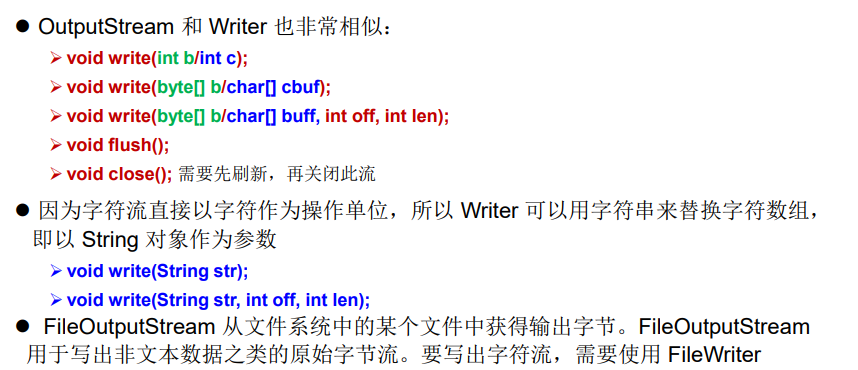
Writer
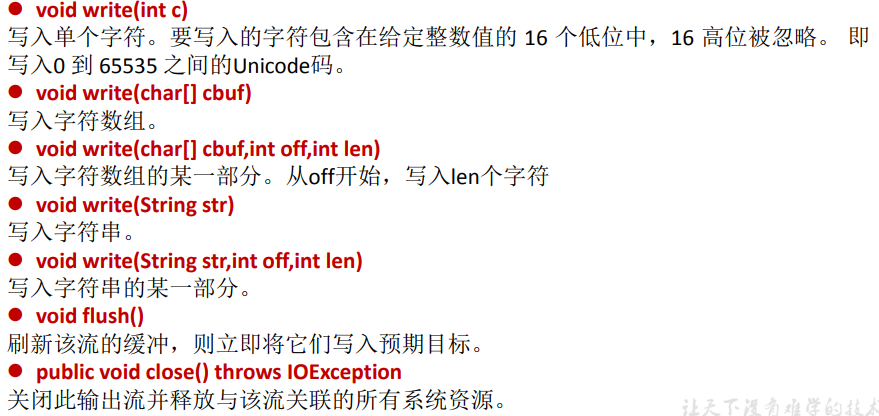
三、节点流(或文件流)
读取文件
@Test
public void test() {
FileInputStream fis = null;
try {
//1.指明要操作的文件
File file = new File("hello.txt");
//2.提供具体的流
fis = new FileInputStream(file);
//3.读数据
byte[] buffer = new byte[5];
int len;//记录每次读取的字节的个数
while ((len = fis.read(buffer)) != -1) {
String str = new String(buffer, 0, len);
System.out.println(str);
}
} catch (IOException e) {
e.printStackTrace();
} finally {
if (fis != null) {
//4.关资源
try {
fis.close();
} catch (IOException e) {
e.printStackTrace();
}
}
}
}
写入文件
@Test
public void testFileWriter() {
FileWriter fw = null;
try {
//1.提供File类的对象,指明写出到的文件
File file = new File("hello1.txt");
//2.提供FileWriter的对象,用于数据的写出
fw = new FileWriter(file, false);
//3.写出的操作
fw.write("I hava a dream\n");
fw.write("aoligei!");
} catch (IOException e) {
e.printStackTrace();
} finally {
//4.流资源的关闭
try {
if (fw != null) {
fw.close();
}
} catch (IOException e) {
e.printStackTrace();
}
}
}
节点流(或文件流):注意点
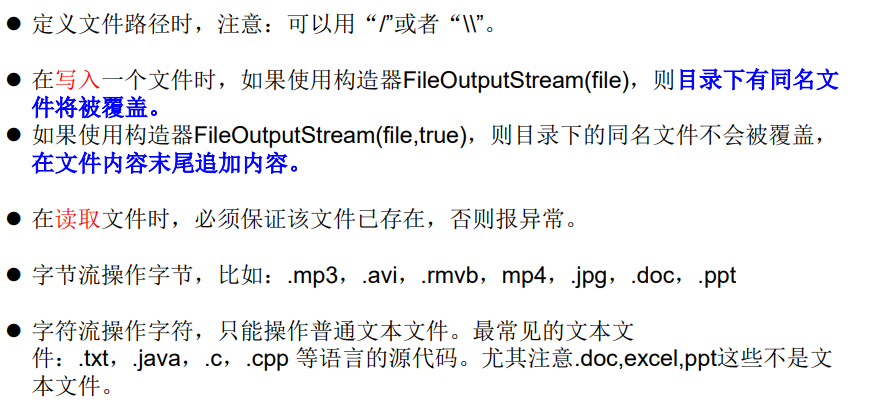
四、缓冲流
什么是缓冲流?
为了提高数据读写的速度,JavaAPI提供了带缓冲功能的流类,在使用这些流类时,会创建一个内部缓冲区数组,缺省使用8192个字节(8Kb)的缓冲区。

缓冲流要“套接”在相应的节点流之上,根据数据操作单位可以把缓冲流分为:
? BufferedInputStream 和 BufferedOutputStream
? BufferedReader 和 BufferedWriter
怎么工作的?
-
当读取数据时,数据按块读入缓冲区,其后的读操作则直接访问缓冲区
-
当使用BufferedInputStream读取字节文件时,BufferedInputStream会一 次性从文件中读取8192个(8Kb), 存在缓冲区中,直到缓冲区装满了,才重新从文件中读取下一个8192个字节数组
-
向流中写入字节时,不会直接写到文件,先写到缓冲区中直到缓冲区写满,BufferedOutputStream才会把缓冲区中的数据一 次性写到文件里。使用方法flush()可以强制将缓冲区的内容全部写入输出流
-
关闭流的顺序和打开流的顺序相反。只要关闭最外层流即可,关闭最外层流也会相应关闭内层节点流
-
flush()方法的使用:手动将buffer中内容写入文件
-
如果是带缓冲区的流对象的close()方法,不但会关闭流,还会在关闭流之前刷新缓冲区,关闭后不能再写出
图解缓冲流
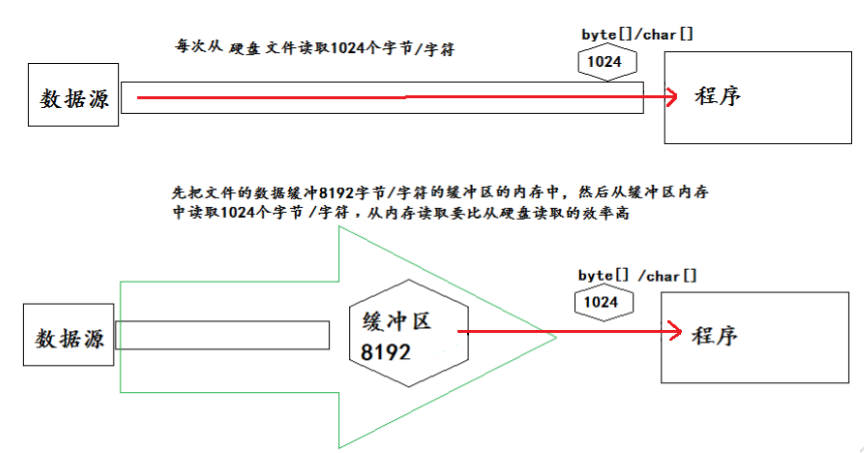
实例
@Test
public void BufferdStreamTest() {
BufferedInputStream bis = null;
BufferedOutputStream bos = null;
try {
//1.造文件
File srcFile = new File("cxk.jpg");
File destFile = new File("cxk3.jpg");
//2.造流
//2.1节点流
FileInputStream fis = new FileInputStream(srcFile);
FileOutputStream fos = new FileOutputStream(destFile);
//2.2缓冲流
bis = new BufferedInputStream(fis);
bos = new BufferedOutputStream(fos);
//3.复制的细节:读取写入
byte[] buffer = new byte[10];
int len;
while ((len = bis.read(buffer)) != -1) {
bos.write(buffer, 0, len);
}
} catch (IOException e) {
e.printStackTrace();
} finally {
//4.资源关闭
//要求:先关闭外层的流,在关闭内层的流
//说明:关闭外层流的同时,内层流会自动进行关闭,关闭内层流的操作可以省略
// fos.close();
// fis.close();
if (bos != null) {
try {
bos.close();
} catch (IOException e) {
e.printStackTrace();
}
}
if (bis != null) {
try {
bis.close();
} catch (IOException e) {
e.printStackTrace();
}
}
}
}
缓冲流练习
package com.caq.exer;
import org.junit.Test;
import java.io.*;
import java.util.HashMap;
import java.util.Map;
import java.util.Set;
/**
* 获取文本上字符出现的次数,把数据写入文件
*
* 思路:
* 1.遍历文本每一个字符
* 2.字符出现的次数存在Map中
*
* Map<Character,Integer> map = new HashMap<Character,Integer>();
* map.put('a',18);
* map.put('你',2);
*
* 3.把map中的数据写入文件
*
*/
public class WordCount {
/*
说明:如果使用单元测试,文件相对路径为当前module
如果使用main()测试,文件相对路径为当前工程
*/
@Test
public void testWordCount() {
FileReader fr = null;
BufferedWriter bw = null;
try {
//1.创建Map集合
Map<Character, Integer> map = new HashMap<Character, Integer>();
//2.遍历每一个字符,每一个字符出现的次数放到map中
fr = new FileReader("dbcp.txt");
int c = 0;
while ((c = fr.read()) != -1) {
//int 还原 char
char ch = (char) c;
//判断char是否在map中第一次出现
if (map.get(ch) == null) {
map.put(ch, 1);
} else {
map.put(ch, map.get(ch) + 1);
}
}
//3.把map中数据存在文件count.txt
//3.1 创建Writer
bw = new BufferedWriter(new FileWriter("wordcount.txt"));
//3.2 遍历map,再写入数据
Set<Map.Entry<Character, Integer>> entrySet = map.entrySet();
for (Map.Entry<Character, Integer> entry : entrySet) {
switch (entry.getKey()) {
case ' ':
bw.write("空格=" + entry.getValue());
break;
case '\t'://\t表示tab 键字符
bw.write("tab键=" + entry.getValue());
break;
case '\r'://
bw.write("回车=" + entry.getValue());
break;
case '\n'://
bw.write("换行=" + entry.getValue());
break;
default:
bw.write(entry.getKey() + "=" + entry.getValue());
break;
}
bw.newLine();
}
} catch (IOException e) {
e.printStackTrace();
} finally {
//4.关流
if (fr != null) {
try {
fr.close();
} catch (IOException e) {
e.printStackTrace();
}
}
if (bw != null) {
try {
bw.close();
} catch (IOException e) {
e.printStackTrace();
}
}
}
}
}
五、转换流
什么是转换流?
转换流提供了在字节流和字符流之间的转换
Java API提供了两个转换流:
? InputStreamReader:将InputStream转换为Reader
? OutputStreamWriter:将Writer转换为OutputStream
字节流中的数据都是字符时,转成字符流操作更高效
很多时候我们使用转换流来处理文件乱码问题。实现编码和解码的功能。
图解
实现将字节的输入流按指定字符集转换为字符的输入流。

实例
package com.caq.java;
import org.junit.Test;
import java.io.*;
/**
转换流
2.作用:提供字节流与字符流之间的转换
3.解码:字节、字节数组--->字符数组、 字符串
编码:字符数组、字符串--->字节、字节数组
4.字符集
* @Date 2021/12/1 15:37
* @Version 1.0
*/
public class InputStreamReaderTest {
/*
此时处理异常的话,仍然应该使用try-catch-finally
InputStreamReader的使用,实现字节的输入流到字符的输入流的转换
*/
@Test
public void test1() throws IOException {
FileInputStream fis = new FileInputStream("dbcp.txt");
//使用系统默认的字符集
// InputStreamReader isr = new InputStreamReader(fis);
InputStreamReader isr = new InputStreamReader(fis,"gbk");
char[] cbuf = new char[20];
int len;
while ((len = isr.read(cbuf)) != -1){
String str = new String(cbuf, 0, len);
System.out.println(str);
}
isr.close();
}
@Test
public void test2() throws IOException {
//指定文件,指定流,用转换流把指定流抱起来
InputStreamReader isr = new InputStreamReader(new FileInputStream("dbcp.txt"),"utf-8");
OutputStreamWriter osw = new OutputStreamWriter(new FileOutputStream("dhcp_gbk.txt"),"gbk");
char[] cbuf = new char[20];
int len;
while ((len = isr.read(cbuf)) != -1){
osw.write(cbuf,0,len);
}
isr.close();
osw.close();
}
}
字符编码
编码表的由来
计算机只能识别二进制数据,早期由来是电信号。为了方便应用计算机,让它可以识别各个国家的文字。就将各个国家的文字用数字来表示,并一一对应,形成一张表。这就是编码表。
常见的编码表
ASCII: 美国标准信息交换码。
用一个字节的7位可以表示。
IS08859-1: 拉丁码表。欧洲码表.
用一个字节的8位表示。
GB2312: 中国的中文编码表。最多两个字节编码所有字符
GBK: 中国的中文编码表升级,融合了更多的中文文字符号。最多两个字节编码
Unicode:国际标准码,融合了目前人类使用的所有字符。为每个字符分配唯一的字符码。 所有的文字都用两个字节来表示
UTF-8: 变长的编码方式,可用1-4个字节来表示-一个字符
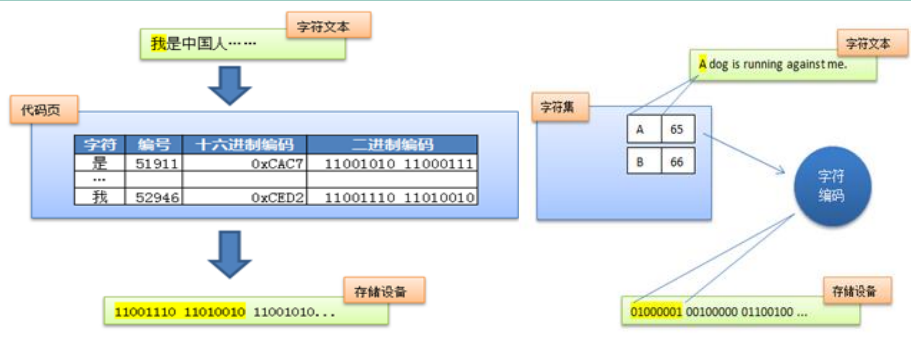
在Unicode出现之前,所有的字符集都是和具体编码方案绑定在一起的(即字 符集≈编码方式),都是直接将字符和最终字节流绑定死了。
GBK等双字节编码方式,用最高位是1或0表示两个字节和一个字节
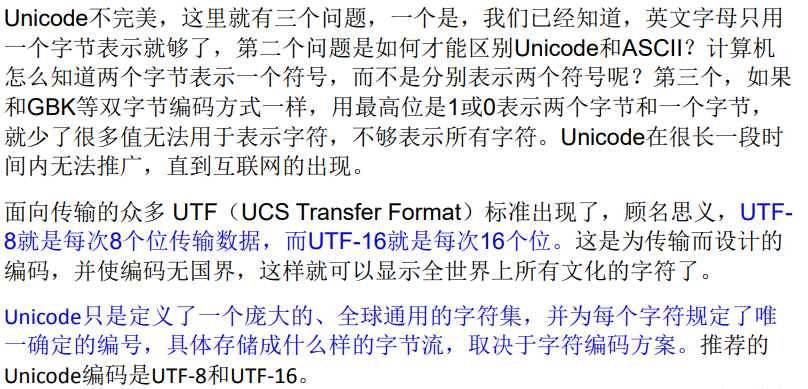
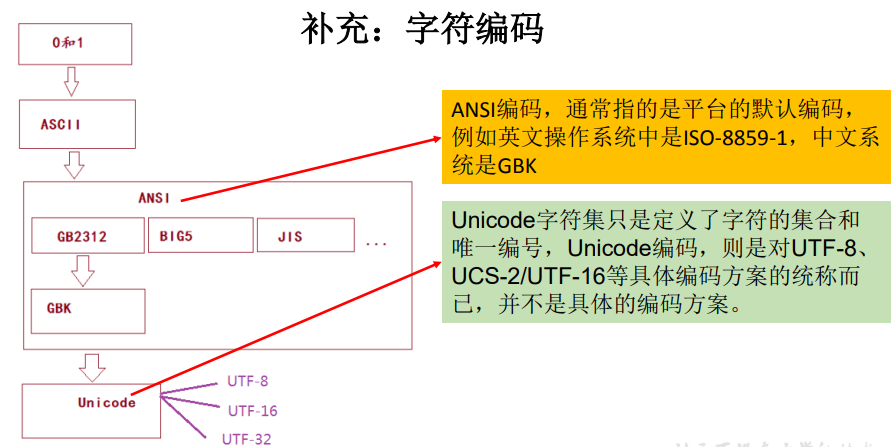
编码:字符串→字节数组
解码:字节数组→字符串
转换流的编码应用
可以将字符按指定编码格式存储
可以对文本数据按指定编码格式来解读
指定编码表的动作由构造器完成
六、标准输入、输出流
System.in和System.out分别代表了系统标准的输入和输出设备
默认输入设备是:键盘,输出设备是:显示器
System.in的类型是InputStream
System.out的类型是PrintStream,其是OutputStream的子类FilterOutputStream的子类
重定向:通过System类的setIn,setOut方 法对默认设备进行改变。
public static void setln(InputStream in)
public static void setOut(PrintStream out)
七、打印流(了解)
实现将基本数据类型的数据格式转化为字符串输出
打印流:
PrintStream和PrintWriter
? ?提供了一系列重载的print()和println()方法,用于多种数据类型的输出
? ?PrintStream和PrintWriter的输出不会抛出IOException异常
? ?PrintStream和PrintWriter有自动flush功能
? ?PrintStream打印的所有字符都使用平台的默认字符编码转换为字节,在需要写入字符而不是写入字节的情况下,应该使用PrintWriter类。
? ?System.out返回的是PrintStream的实例
八、数据流(了解)
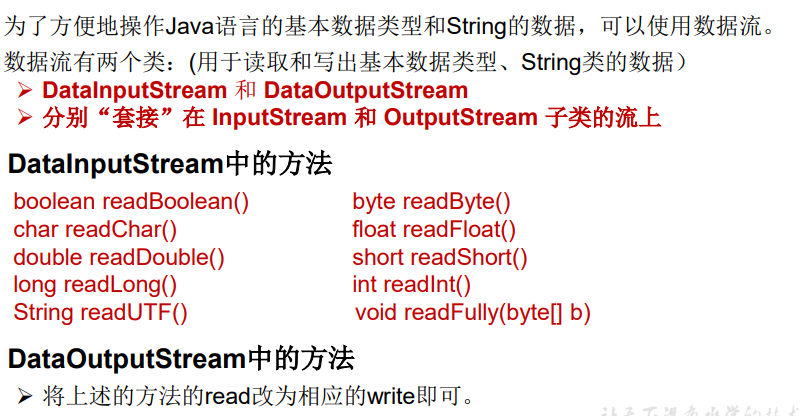
九、对象流
ObjectInputStream和OjbectOutputSteam
用于存储和读取基本数据类型数据或对象的处理流。它的强大之处就是可 以把Java中的对象写入到数据源中,也能把对象从数据源中还原回来。
序列化:用ObjectOutputStream类保存基本类型数据或对象的机制
反序列化:用ObjectInputStream类读取基本类型数据或对象的机制
ObjectOutputStream和ObjectInputStream不能序列化static和transient修饰的成员变量
对象的序列化
对象序列化机制允许把内存中的Java对象转换成平台无关的二进制流,从 而允许把这种二进制流持久地保存在磁盘上,或通过网络将这种二进制流传 输到另一个网络节点。//当其它程序获取了这种二进制流,就可以恢复成原 来的Java对象
序列化的好处在于可将任何实现了Serializable接口的对象转化为字节数据, 使其在保存和传输时可被还原
序列化的好处在于可将任何实现了Serializable接口的对象转化为字节数据, 使其在保存和传输时可被还原
Serializable
Externalizable
-
凡是实现Serializable接口的类都有一个表示序列化版本标识符的静态变量:
?private static final long serialVersionUID;? ?serialVersionUID用来表明类的不同版本间的兼容性。简言之,其目的是以序列化对象进行版本控制,有关各版本反序列化时是否兼容。
? ?如果类没有显示定义这个静态常量,它的值是Java运行时环境根据类的内部细节自动生成的。若类的实例变量做了修改,serialVersionUID 可能发生变化。故建议,显式声明。 -
简单来说,Java的序列化机制是通过在运行时判断类的serialVersionUID来验
证版本一致性的。在进行反序列化时,JVM会把传来的字节流中的serialVersionUID与本地相应实体类的serialVersionUID进行比较,如果相同
就认为是一致的,可以进行反序列化,否则就会出现序列化版本不一致的异
常。(InvalidCastException)
流程总结
-
若某个类实现了Serializable 接口,该类的对象就是可序列化的:
?创建一个ObjectOutputStream
?调用ObjectOutputStream对象的writeObject(对象)方法输出可序列化对象
?注意写出一次,操作flush()一次 -
反序列化
?创建一个ObjectInputStream
?调用readObject()方法读取流中的对象 -
强调:如果某个类的属性不是基本数据类型或String类型,而是另一个引用类型,那么这个引用类型必须是可序列化的,否则拥有该类型的Field的类也不能序列化
实例
Person类
package com.caq.java;
import java.io.Serializable;
/**
Person类需要满足如下要求方可序列化
1.需要实现Seriallizable接口
2.提供一个全局常量static final long serialVersionUID = 42L;
3.除了当前Person类需要实现Serializable接口之外,还必须保证其他所有属性
是可序列化的!
默认情况下,基本数据类型是可序列化的
4.对象序列化机制允许把内存中的Java对象转换成平台
无关的二进制流,从 而允许把这种二进制流持久地保存在磁盘上,或通过网络将这种二进制流传 输到另一个网络节点。//当其它程序获取了这种二进制流,就可以恢复成原 来的Java对象
* @Date 2021/12/2 18:14
* @Version 1.0
*/
public class Person implements Serializable {
public static final long serialVersionUID = 56354763763L;
private String name;
private int age;
public Person() {
}
public Person(String name, int age) {
this.name = name;
this.age = age;
}
public String getName() {
return name;
}
public void setName(String name) {
this.name = name;
}
public int getAge() {
return age;
}
public void setAge(int age) {
this.age = age;
}
@Override
public String toString() {
return "Person{" +
"name='" + name + '\'' +
", age=" + age +
'}';
}
}
对象流
package com.caq.java;
import org.junit.Test;
import java.io.*;
/**
* ObjectInputStream和ObjectOutputStream
* 作用:用于存储和读取基本数据或对象的处理流,
* 它的强大之处就是可以把Java中的对象写入到数据源中,也能把对象从数据源中还原回来
*
* @Date 2021/12/2 17:18
* @Version 1.0
*/
public class ObjectInputOutputStreamTest {
/**
* 将内存中的Java对象保存到磁盘中或通过网络传输出去
* 使用ObjectOutputStream实现
*/
//序列化单元测试
@Test
public void testObjectOutputStream() {
ObjectOutputStream oos = null;
try {
//1.创建序列化流
oos = new ObjectOutputStream(new FileOutputStream("object.dat"));
//2.
oos.writeObject(new String("我爱你!"));
oos.flush();//刷新操作
oos.writeObject(new Person("朱茵",12));
oos.flush();//刷新操作
} catch (IOException e) {
e.printStackTrace();
} finally {
if (oos != null) {
try {
oos.close();
} catch (IOException e) {
e.printStackTrace();
}
}
}
}
//反序列化测试
@Test
public void testObjectOutputStream2() {
ObjectInputStream ois = null;
try {
//反序列化流
ois = new ObjectInputStream(new FileInputStream("object.dat"));
Object obj = ois.readObject();
String str = (String) obj;
Person p = (Person)ois.readObject();
System.out.println(p);
System.out.println(str);
} catch (IOException e) {
e.printStackTrace();
} catch (ClassNotFoundException e) {
e.printStackTrace();
} finally {
if (ois != null) {
try {
ois.close();
} catch (IOException e) {
e.printStackTrace();
}
}
}
}
}
谈谈你对java.io.Serializable接口的理解
它用于序列化, 是空方法接口
试下了Serializable接口的对象可将它们转化为一系列字节,并在以后可以将它们恢复成原来的样子。这个过程我们可以通过网络进行,这也就意味着序列化机制可以解决操作系统之间的差异的,就比如我们可以windows上序列化一个对象,我们能在unix系统上重新恢复这个对象。不必关心数据在不同机器上如何表示,也不必关心字节的顺序或者其他细节
手打的好累,,,背它!!!!!!!!!!
由于大部分作为参数的类String、Integer等都实现了Serializable接口,可以利用多态的性质,作为参数使接口更灵活
十、随机存取文件流
RandomAccessFile 类
RandomAccessFile 声明在java.io包下,但直接继承于java.lang.Object类。并 且它实现了DataInput、DataOutput这两个接口,也就意味着这个类既可以读也 可以写。
RandomAccessFile 类支持 “随机访问” 的方式,程序可以直接跳到文件的任意 地方来读、写文件
? 支持只访问文件的部分内容
? 可以向已存在的文件后追加内容
RandomAccessFile 对象包含一个记录指针,用以标示当前读写处的位置。
? RandomAccessFile 类对象可以自由移动记录指针:
? long getFilePointer():获取文件记录指针的当前位置
? void seek(long pos):将文件记录指针定位到 pos 位
构造器 public RandomAccessFile(File file, String mode)
public RandomAccessFile(String name, String mode)
创建 RandomAccessFile 类实例需要指定一个 mode 参数,该参数指定RandomAccessFile 的访问模式:
?r: 以只读方式打开
?rw:打开以便读取和写入
?rwd:打开以便读取和写入;同步文件内容的更新
?rws:打开以便读取和写入;同步文件内容和元数据的更新
如果模式为只读r。则不会创建文件,而是会去读取一个已经存在的文件, 如果读取的文件不存在则会出现异常。 如果模式为rw读写。如果文件不 存在则会去创建文件,如果存在则不会创建。
实例
package com.caq.java;
import org.junit.Test;
import java.io.File;
import java.io.IOException;
import java.io.RandomAccessFile;
/**
* ?RandomAccessFile 声明在java.io包下,但直接继承于java.lang.Object类。并
* 且它实现了DataInput、DataOutput这两个接口,也就意味着这个类既可以读也
* 可以写。
*
* @Date 2021/12/2 20:27
* @Version 1.0
*/
public class RandomFile {
@Test
public void test1() {
RandomAccessFile raf1 = null;
RandomAccessFile raf2 = null;
try {
raf1 = new RandomAccessFile(new File("img/cxk.jpg"), "r");
raf2 = new RandomAccessFile(new File("cxk1.jpg"), "rw");
byte[] buffer = new byte[1024];
int len;
while ((len = raf1.read(buffer)) != -1) {
raf2.write(buffer, 0, len);
}
} catch (IOException e) {
e.printStackTrace();
} finally {
if (raf1 != null){
try {
raf1.close();
} catch (IOException e) {
e.printStackTrace();
}
}
if (raf2 !=null){
try {
raf2.close();
} catch (IOException e) {
e.printStackTrace();
}
}
}
}
//如果RandomAccessFile作为输出流时,写出到的文件如果不存在,则在执行过程中自动创建
//如果写出到的文件存在,则会对原有文件内容进行覆盖。
//默认从头开始覆盖
@Test
public void test2() throws IOException {
RandomAccessFile raf1 = new RandomAccessFile("hello.txt", "rw");
raf1.seek(3);
raf1.write("xyz".getBytes());
raf1.close();
}
//用RandomAccessFile实现数据的插入效果
@Test
public void test3() throws IOException {
RandomAccessFile raf1 = new RandomAccessFile("hello.txt", "rw");
raf1.seek(3);//指针遇到角标为3的位置
byte[] buffer = new byte[20];
int len;
while ((len = raf1.read(buffer)) != -1){
}
}
}
小节
流是用来处理数据的。
处理数据时,一定要先明确数据源,与数据目的地
? 数据源可以是文件,可以是键盘。
? 数据目的地可以是文件、显示器或者其他设备。
而流只是在帮助数据进行传输,并对传输的数据进行处理,比如过滤处理、 转换处理等